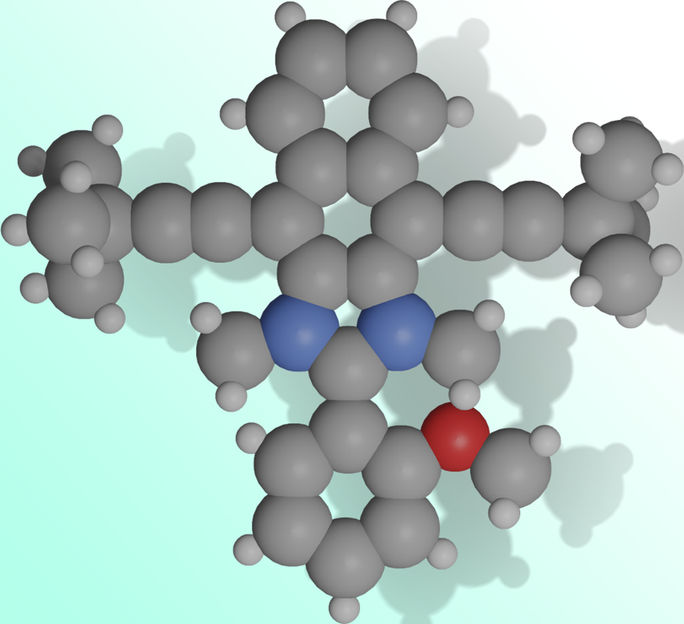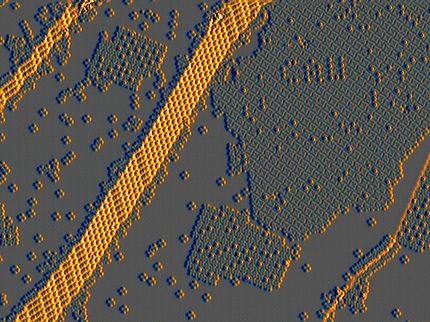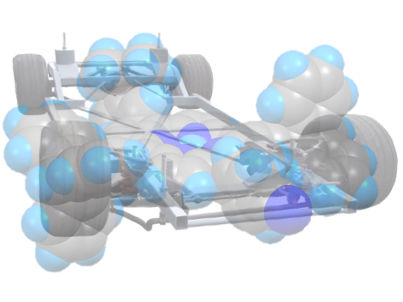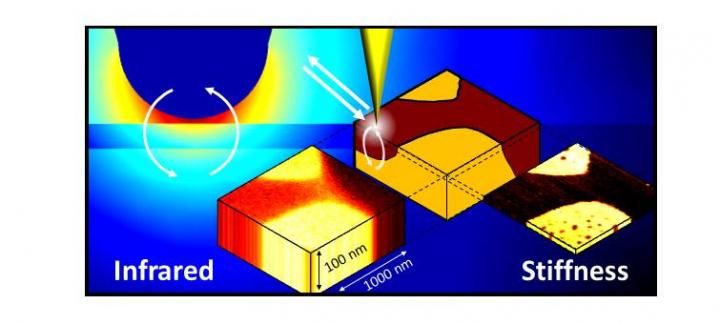NanoCar Race II: Eight teams from three continents gather for the world's smallest race - the race of the molecules
Advertisement
When they hear the term "24-hour race," many people might think of Le Mans, Daytona, or even the Nürburgring. Images of colorful cars racing by at breakneck speed, accompanied by deafening noise and the smell of burning high-performance fuels may appear in the mind's eye. But at the NanoCar Race everything is different! And in the middle of it all is a team from TU Dresden and IPF Dresden.

Schematic view of the nanocar from the German team #GAzE. The core of the molecular race car is an azulene molecule. Additional atomic groups have been added to match mobility and controllability goals.
Tim Kühne
A very different 24-hour race
At the end of March, the second NanoCar Race will take place in Toulouse at the French CNRS (Centre National de la Recherche Scientifique). With this special kind of race, pretty much everything is different from a classic car race! Strictly speaking, only the race drivers are sitting there, while the "race tracks" are located in eight different laboratories around the world - one of them at the TU Dresden. That being said, the participating "cars" are very, very small - molecules made up of 50 to 200 atoms, no bigger than a few nanometers. To put this size regime in perspective: A single human hair is about 70,000 nanometers thick.
A microscope as an engine?
In this quantum world, of course, nothing can be monitored with the naked eye or even by using classical light microscopes – one needs very special high-tech machines, the so-called scanning tunneling microscopes (STM). In such microscopes, a sharp, atomically precise tip acts as the probe and traverses over the sample. A voltage is applied between the probe and the sample, leading to quantum mechanical effects. These effects can then be exploited to obtain structural information about the sample, all the way down to atomic resolution. In the NanoCar race, however, the STMs are not only used to study the tiny racing cars, but to manipulate them as well. This is because molecules with certain specific structures and properties can be coaxed into moving with electrical impulses. The propulsion mechanism can be either inelastic (related to the excitation of vibrational modes or to current-induced structural changes) or dipolar, resulting from the repulsion or attraction between the nanocar and the STM tip. In short, electrons from the tip to the sample are sufficient to trigger motion in well-designed nanocars.
Herein lies the key to victory for the racing teams: which molecule is best fitted to travel as far as possible within the allotted 24 hours? "Far" is, of course, a relative term here - the distances covered will be a few nanometers at best. Nevertheless, the organizers of this quantum race have spared no efforts to make everything look like a classical sports event! There will be a 24-hour live stream, interspersed with reports on the individual teams, and official statements ranging from politics to science. As is customary at the conclusion of any racing event, there will also be a state-of-the-art awards ceremony!
The first Nanocar race took place in April 2017 and was followed live on the YouTube channel by more than 100,000 people worldwide.
The second international nanocar race is organized within the EU-funded FET OPEN project "MEMO" (Mechanics with Molecules). The project is led by Dr. Francesca Moresco, head of the "Single Molecule Machines" (SMM) Group at the Center for Advancing Electronics Dresden (cfaed) at TU Dresden.
Fundamental research, embedded in accessible format
What sounds like great fun has, at the core, a serious scientific purpose. Fundamental research on mobile, selectively controllable molecules paves the way for future scientific endeavors and applications. Even if it sounds closer to science fiction than science today, soon such nanocars may be used to distribute medical agents in the human body, serve as motors in performing the work of tiny micromachines, or be used as an alternative method for computing complex problems.
The Dresden Team
The Dresden team GAzE (German Azulene Explorer) includes the entire SMM group (coordinators and pilots) as well as Dr. Franziska Lissel and Oumaima Aiboudi (Functional Electronic Materials Group at the Leibniz Institute of Polymer Research Dresden - IPF) for the chemical synthesis, and Dr. Dmitry Ryndyk (TU Dresden, Chair of Theoretical Chemistry / Leibniz Institute of Materials Science IFW), responsible for theoretical calculations and modelling.
The Dresden nanocar has a core of azulene, which provides a high dipole moment, while lateral groups help to decouple it from the surface. Azulene is a blue aromatic hydrocarbon used in cosmetic products and as a coloring agent. The best-known natural azulene compound occurs in chamomile. During the Renaissance, this deep blue essential oil was quite popular and used to be obtained via steam distillation.
List of certified teams for the March 2022 Nanocar Race II
- StrasNanocar (University of Strasbourg / France)
- SanCar (CFM-CSIC San Sebastian and University of Santiago de Compostela/ SPAIN)
- GAzE (TU Dresden and IPF Dresden, Germany)
- Rice-Graz NanoPrix (University of Graz, Austria / Rice University, USA)
- NANOHISPA (IMDEA Madrid, Spain)
- TOULOUSE-NARA (CNRS and University of Toulouse, France / NAIST Nara, Japan)
- Ohio Bobcat Nanowagon (Ohio University, USA)
- NIMS-MANA (NIMS-MANA Tsukuba, Japan)
Other news from the department science
Most read news
More news from our other portals
Last viewed contents
© 1997-2025 LUMITOS AG, All rights reserved

































































